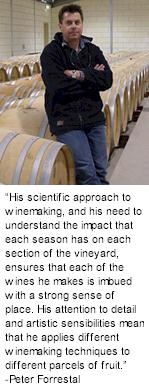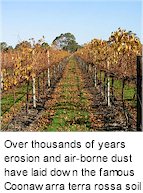


Parker Coonawarra Estate is situated in Coonawarra, at the centre of South Australia's Limestone Coast Wine Region. It is approximately 3 1/2 hours south of Adelaide, the capital of South Australia, and about 4 hours west of Melbourne, the capital of Victoria. Only a short drive from Coonawarra to the east is the beautiful Grampians Region, and the stunning Great Ocean Road to the south east.

Parker Coonawarra Estate was established in 1985 on the rich Terra Rossa soil over limestone of Coonawarra and carries Cabernet Sauvignon as the predominant variety with minor plantings of Merlot and Petit Verdot. Commercial constraints played no part in the development of Parker Coonawarra Estate. John Parker, whose many years involvement in the wine industry resulted in a desire to produce a premium wine from Australia's premier red wine district culminated with the release of the 1988 Terra Rossa First Growth in 1991.
Coonawarra did not happen by chance. Nor did it evolve by trial and error. It was founded a century ago, and was based on sound scientific principles after the assessment of extensive feasibility studies. The founder was John Riddoch. He had come to Australia from Scotland during the Gold Rush and subsequently acquired an extensive pastoral run in the South East of South Australia. His motives for establishing Coonawarra were primarily humanitarian. As he said at the time, he aimed to provide employment, to encourage immigration and to stimulate closer settlement by sub-dividing his large estate.
Since then, Coonawarra has passed through three historical periods. The first was early settlement, when the early settlers accepted the challenge of Riddoch's vision, established the district, and generally prospered until the time of the First World War. They were led by Joseph Darwent. Then came the dark age of the Great Depression and the two World Wars. During this period Riddoch's original Cellars were converted into a distillery, and the Redman family alone were able to maintain a continuous tradition of table wine production.

Samuel Wynn eventually recognised the quality of these wines, and initiated the renaissance of the district by purchasing the old Riddoch Cellars in 1951. This third historical period witnessed the appreciation by many other investors of the truly great attributes of this small, yet magic, tract of terra rossa soil. During the half century since then, the combined efforts of many outstanding grapegrowers and talented winemakers have ensured that Coonawarra has produced wine of a truly unique style and quality. These wines are now generally recognised as Australia's best, and amongst the greatest in the world.
It has been an exciting time for Parker Coonawarra Estate, also celebrating the Terra Rossa First Growth’s Outstanding classification in Langton’s. The Langton’s 2005 Classification notes the First Growth as a "brilliantly seductive wine with unbelievable depth of fruit, balance and structure." Parker Estate celebrated further victory at the 2005 Winewise Small Vignerons Awards where the 2003 Parker Estate Terra Rossa Cabernet Sauvignon won the trophy for best Cabernet Sauvignon. Competition was very strong among 1318 entries received from 329 entrants.
